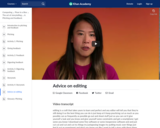
Advice on editing.
- Subject:
- Applied Science
- Arts and Humanities
- Computer Science
- Graphic Arts
- Material Type:
- Lesson
- Provider:
- Khan Academy
- Provider Set:
- Pixar
- Author:
- Disney Pixar
- Khan Academy
- Date Added:
- 07/15/2021

Advice on editing.
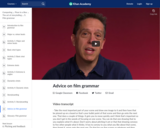
Advice for storytellers.
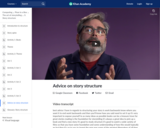
Advice from storytellers on structure.
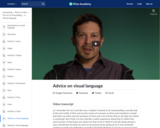
Advice from our storytellers.

The aim of this book is to provide a one-stop repository for first-hand evidence on COVID, eliminating concerns about payments and subscriptions for people in developing countries. This activity is aligned with SDG3-Good Health and Well-Being, SDG4 – Quality Education, SDG9-Industry, Innovation and Infrastructure, SDG10-Reduced Inequality, and SDG17-Partnerships for the Goals.
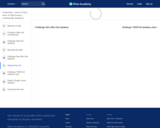
How to combine data from a database using SQL.
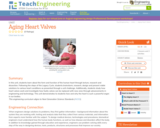
In this unit, students learn about the form and function of the human heart through lecture, research and dissection. Following the steps of the Legacy Cycle, students brainstorm, research, design and present viable solutions to various heart conditions as presented through a unit challenge. Additionally, students study how heart valves work and investigate how faulty valves can be replaced with new ones through advancements in engineering and technology. This unit demonstrates to students how and why the heart is such a powerful organ in our bodies

The Agriscience/Intro to Agriculture course helps students acquire a broad understanding of a variety of agricultural areas, develop an awareness of the many career opportunities in agriculture, participate in occupationally relevant experiences, and work cooperatively with a group to develop and expand leadership abilities. Students study California agriculture, agricultural business, agricultural technologies, natural resources, and animal, plant, and soil sciences.

Do you need proof that driving is a dangerous activity? More Americans have died in car crashes over the past 100 years than in all the wars the U.S. has ever fought combined. More than 40,000 Americans die each year on the nation's highways, most as the result of high-speed collisions. In this video segment adapted from NOVA, learn how engineers developed the air bag, an important automobile-safety device now found in most cars.
Recommended for: Grades 3-12

Students are introduced to measuring and identifying sources of air pollution, as well as how environmental engineers try to control and limit the amount of air pollution. In Part 1, students are introduced to nitrogen dioxide as an air pollutant and how it is quantified. Major sources are identified, using EPA bar graphs. Students identify major cities and determine their latitudes and longitudes. They estimate NO2 values from color maps showing monthly NO2 averages from two sources: a NASA satellite and the WSU forecast model AIRPACT. In Part 2, students continue to estimate NO2 values from color maps and use Excel to calculate differences and ratios to determine the model's performance. They gain experience working with very large numbers written in scientific notation, as well as spreadsheet application capabilities.

In this video segment adapted from ZOOM, cast members make their own hovercraft and demonstrate how the air leaking out of a balloon can make a plastic plate hover above a table.
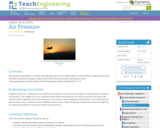
Air pressure is pushing on us all the time although we do not usually notice it. In this activity, students learn about the units of pressure and get a sense of just how much air pressure is pushing on them.

Students are introduced to air masses, with an emphasis on the differences between and characteristics of high- versus low-pressure air systems. Students also hear about weather forecasting instrumentation and how engineers work to improve these instruments for atmospheric measurements on Earth and in space.
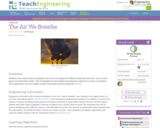
Students learn what causes air pollution and how to investigate the different pollutants that exist, such as toxic gases and particulate matter. They investigate the technologies developed by engineers to reduce air pollution.

In this video adapted from Storyknife Productions, Alaska Native pilots share how they use traditional knowledge to read the landscape and predict the weather.

In this video adapted from KUAC-TV and the Geophysical Institute at the University of Alaska, Fairbanks, Alaska Native students contribute to research on how their environment is changing as a result of global warming.

In this video adapted from Alaska Sea Grant, discover why multiple tsunamis resulted from the Great Alaska Earthquake of 1964.
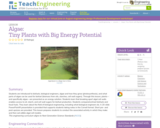
Students are introduced to biofuels, biological engineers, algae and how they grow (photosynthesis), and what parts of algae can be used for biofuel (biomass from oils, starches, cell wall sugars). Through this lesson, plants—and specifically algae—are presented as an energy solution. Students learn that breaking apart algal cell walls enables access to oil, starch, and cell wall sugars for biofuel production. Students compare/contrast biofuels and fossil fuels. They learn about the field of biological engineering, including what biological engineers do. A 20-slide PowerPoint® presentation is provided that supports students taking notes in the Cornell format. Short pre- and post-quizzes are provided. This lesson prepares students to conduct the associated activity in which they make and then eat edible algal cell models.

This lesson centers around the How AI Works: Equal Access and Algorithmic Bias video from the How AI Works video series. Watch this video first before exploring the lesson plan.
In this lesson, students will practice cropping images to uncover the bias underlying the Twitter cropping algorithm. Then, students will read and watch a video about the discovery of this biased algorithm. Finally, students will discuss ways to recognize and reduce bias along with analyzing Twitter's response to the allegations of bias in their cropping algorithm.
This lesson can be taught on its own, or as part of a 7-lesson sequence on How AI Works. Duration: 45 minutes
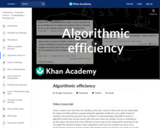
How can we improve the speed of a (deterministic) primality test? Created by Brit Cruise.